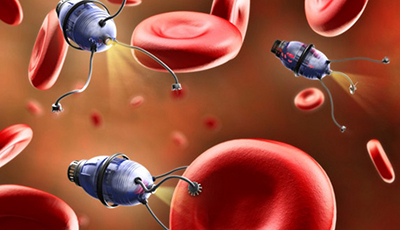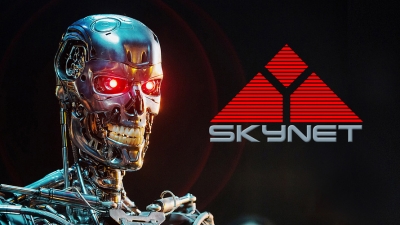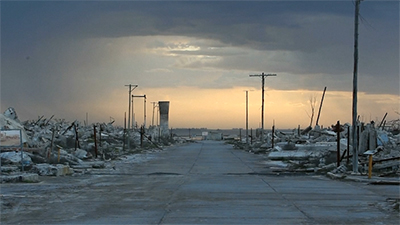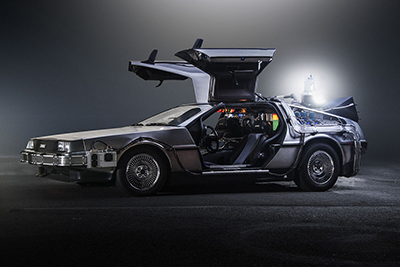The 25 Greatest Science Fiction Tropes, Ranked
by Ross Johnson, for the Barnes and Noble Sci-Fi & Fantasy Blog., January 16, 2019

Genre categories can be helpful in guiding us toward works that we might like, or just are in the mood to read, but those definitions can be slippery, and many of the very best books defy conventions and upend expectations. Perhaps we'd be better off judging books by their tropes—those storytelling devices that we see again and again, not because writers are out of ideas, but because they work. Some consider "trope" to be a bad word, but it's better to think of them as tools: they''re useful when used with a purpose.
Here is Johnson's "definitive" ranking of 25 all-time great science fiction tropes. Each entry is supplemented by material from TVTropes.org, one of the best crowd-sourced wikis out there.

25. Cryosleep
There’s cool stuff in space, sure, but 99.9% of it is pretty empty. And dull. So dull, in fact, that knocking people out for long journeys between stars has become a trope. Cryosleep (aka suspended animation) involves a character or characters that are placed in something like an induced coma for the duration of a long voyage, or perhaps in order to survive over long spans of time. Think Rip Van Winkle, or, if you're a bit less classy, Encino Man. Khan preserved himself for centuries before wreaking his wrath on Captain Kirk, and the several members of the ill-fated crew of the Odyssey in the film and novel versions of 2001: A Space Odyssey napped their ways to Jupiter. Books can include cryosleep as a background element (Mur Lafferty’s recent award-nominee Six Wakes follows a crew of clones ferrying slumbering cargo across the stars) or foreground it into the plot (Adrian Tchaikovsky's Children of Time shows us the evolution of an entire alien species, but keeps its human characters alive for the duration, only popping them out of hibernation once a generation), so the trope is often about much more than a clever way to skip past the boring parts.
From TV Tropes: The Human Popsicle || Cryonics Failure || Sleeper Starship

24. Generation Ships
Again, the thing about space is… there’s a lot of it, and it takes a really, really long time to get anywhere. A good percentage of outer-space science fiction prefers to avoid coping with the vast distances between stars by sending ships down wormholes (see below) or through hyperspeed (see further below, FTL). Scientists and writers have long suggested that the only true means of getting people from one star to another in the vastness of space is by packing a bunch of families onto a very large ship and sending them all off on a journey that might take centuries. Crews of fictional generation ships face all the usual dangers inherent in space travel, with the additional complication that anyone who actually had a choice about being there will be dead before the ship actually gets anywhere. Robert Heinlein wrote one of the most famous early works using the trope in Orphans of the Sky, while Elizabeth Bear (the Jacob's Ladder trilogy) and Kim Stanley Robinson (Aurora, which posits we're probably better off staying at home) have produced notable recent examples.
From TV Tropes: Generation Ships || Colony Ship || Planet Spaceship

23. Psychics
Science fiction is often seen (fairly!) as a particularly cerebral genre, so why wouldn’t many of its characters have super-powerful brains? We know what you're thinking—it might not be the most science-y of sci-fi tropes, but plenty of novels suggest that psychic powers are just around the corner in human evolution. Sometimes, as in Alfred Bester’s The Demolished Man, the powers are a genetic quirk of particular individuals. A Stranger in a Strange Land suggests that you too can be psychic; you just have to practice. Which sounds like work, which makes Frank Herbert’s vision in Dune so appealing: drugs will open the door to the powers of the mind. Psychic powers come in a lot of flavors, but it’s not surprising that readers are drawn to the idea that the brain might be the most powerful muscle of all.
From TV Tropes: Psychic Powers || Humans Are Psychic In The Future || Telepathic Spacemen

22. Ancient Astronauts
Sci-fi can be bold and optimistic, but there are also strong strains of cynicism wending through the genre: warnings against excess pride, the hubris of man, yadda yadda. Ancient astronaut themes tend to run along these lines: you weren’t the first ones here, and/or you didn’t build that (the pyramids, for example), so sit down. Sometimes the aliens seeded life on our world, sometimes they interacted with early humans to either teach or terrify, and sometimes we learn that THEY NEVER LEFT. In a twist, David Brin’s Uplift series posits that humanity is one of only two sentient species to have progressed into the wider galactic civilization without any help, making it one of the few instances of the trope in which we humans get to be justifiably proud of ourselves.
From TV Tropes: Ancient Astronauts || Precursors || Our Ancestors Are Superheroes

21. Space Pirates
In real life, pirates are kind of scary. In fiction, pirates (good and bad) represent freedom, romance, adventure, and loads of space booty (loot, not the other kind—but sometimes the other kind). Space opera often translates the characteristics of seafaring adventure into space, so it makes perfect sense that piracy and privateering would have a role to play. Space pirates, though, are rarely antagonists, and almost always the coolest characters in the book. Though a mainstay of early pulp sci-fi, pirates and scoundrels are just as prevalent in modern works: K.B. Wagers Behind the Throne (space princess becomes a gunrunner), Tim Pratt’s The Wrong Stars (mercenary crew makes first contact), R.E. Stearns' Barbary Station (two girls in love run off to join the most notorious pirate crew in the 'verse).
From TV Tropes: Space Pirates || Space Is An Ocean || Salvage Pirates

20. Uploaded Consciousness
We like this one because it presents a host of philosophical quandaries, centered around the question of what makes us who we are. If my mind is copied and uploaded to a computer (or an android, or another body, etc.), am I still me? Even if the copy is flawless? And am I responsible for the thoughts and actions of a replica? Science fiction authors have taken on the question from all sides: in Richard Morgan's Altered Carbon, everyone is given an implanted gadget that records everything they experience and recall as a handy back-up that can be loaded into a fresh "sleeve" should anything happen to the original (the same idea is employed to more humorous ends in Cory Doctorow's Down and Out in the Magic Kingdom). Alastair Reynolds Revelation Space books offer a dual path, featuring both sentient copies of minds as well as replicas that function by predicting the choices that you might make. In Ferrett Steinmetz' The Uploaded, digital consciousness subs in for the afterlife, with grand complications. In science fiction, you may not be immortal, but your back-up copy might be.
From TV Tropes: Brain Uploading || Body Backup Drive || Inside A Computer System

19. Benevolent Aliens
Occasionally, aliens are friendly. Helpful, even. Think of Superman, having been evicted from his doomed home planet before settling somewhere in Kansas and dedicating his life to the betterment of his adopted homeworld. Of course, the best aliens are never entirely explicable, and ideas of benevolence might not entirely cross the species barrier. Aliens give the Earth a helping hand, but also a warning, in Harry Bates' tough-love classic “Farewell to the Master” (the basis for The Day the Earth Stood Still). In Octavia Butler's Lilith's Brood, aliens save humanity, from doom but without much regard for the things that made us human. The aliens of Arthur C. Clarke's Childhood's End strike a not dissimilar bargain.
From TV Tropes: Benevolent Alien Invasion || Humans Need Aliens || Superior Species

18. Killer Aliens
Evil aliens bent on domination, on the other hand, can literally ruin your entire day, but there’s often a failsafe (unless you’re in an H.P. Lovecraft story). H.G. Wells taught us to look for a weakness, even something as prosaic as common Earth bacteria (again, if you're in a Lovecraft story… best not to bother). Killer extraterrestrials can take many forms, from the amorphous thing of John W. Campbell’s horrific Who Goes There? to harmless-looking triffids, to the ambiguous invaders of Cixin Liu’s The Three-Body Problem. Traditionally, invading aliens served as stand-ins for ideas about imperialism and colonialism but, like all monsters, they can also represent any number of more down-to-earth anxieties.
From TV Tropes: Aliens Are Bastards || Scary Dogmatic Aliens || Planet Looters

17. Alien Artifacts
Aliens. When they’re not killing us or uplifting our civilization, they’re leaving their junk lying around. It seems as though science fiction protagonists are constantly digging up, mining out, or just picking up some piece of alien technology or culture left behind by either recent or ancient alien visitors to a world populated by humanity. Alien trash is typically our treasure, a point driven home in David Brin’s Existence, about an orbital trash collector who finally stumbles upon an object of genuinely extraterrestrial origin.

16. Nanotechnology
Another sci-fi trope that once seemed outlandish, nanotech is now a cutting-edge field in real life. Science fiction, naturally, teaches us to be wary: manipulating matter on molecular scales can offer tremendous benefits, but once we get to the point of injecting ourselves with tiny, frequently self-replicating machines, we’re in the danger zone. Neal Stephenson’s The Diamond Age suggests a middle ground: a world in which nanotech is useful and available for all sorts of uses. Foresighted as always, Stephenson’s world, like an only slightly advanced version of our own, sees nanotech more as a fact of the near-future, with uses for both good and ill. For a full consideration of the theme, check out Linda Nagata's Nanotech Succession series, which tracks the evolution of nanotech across time in multiple largely standalone novels.

15. Wormholes
Wormholes work as a means of science-fictional transportation because they’re almost, kinda plausible. The closest thing we have to a working model of faster-than-light travel is the conjecture, springing from general relativity, that there might be tunnels through space linking very distant points. Good enough! Or good enough, at least, that wormholes form the basis of many an interstellar economy, from Joan D. Vinge's The Snow Queen to Lois McMaster Bujold's Vorkosigan Saga. And, they don’t even have to be in space, making them handy for moving people as well as ships: Will Parry of the His Dark Materials series discovers one in the middle of Oxford, and the suburban tesseracts of the Wrinkle in Time are explicitly the same thing. Heck, the great Carl Sagan suggested that you might even meet your parents at the other end of one of them. It’s no muss, no fuss galactic transport.

14. Parallel Worlds
What if? That’s the core question of any speculative fiction, but the idea of parallel worlds distills it down even further: what if there were another you, or another world running alongside our own. What if our own reality were just one of many? Sometimes this involves an escape into one of these alternate realities, and just as often an incursion into our own. Robert Heinlein made excellent use of the trope in his brilliantly on-the-nose The Number of the Beast: universes are called “fictions,” representing fictional worlds that the book’s travelers can visit. Before it’s over, Heinlein himself pays a visit to an inter-dimensional sci-fi convention. Peter Clines' The Fold employs some misdirection before showing us a dark, dark parallel universe—which sci-fi warns us to look out for. The trope is so firmly established that John Scalzi uses it as an excuse to explain how FTL travel works in Old Man's War: Your ship's "skip drive" just punches a hole into an essentially identical alternate dimension where your ship is where you want it to be. Or something.

13. Interspecies Romance
Love is love, so if Ann Darrow wants to make time with King Kong, who are we to judge? Sometimes, as in Becky Chambers The Long Way to a Small, Angry Planet, interspecies romance is a given when many different aliens (or artificial intelligences) live and work together. Romantic and sexual complications are expected, but not stigmatized. In other works, like Philip José Farmer’s Strange Relations or Philip K. Dick's Do Androids Dream of Electric Sheep?, such love is forbidden and dangerous. The trope persists not only because of the appeal of a good love story, but because queer and interracial (and queer interracial) romances in our real world remain fraught.

12. AI Uprisings
“I can't do that Dave." The most famous instance of a rogue artificial intelligence (in Arthur C. Clarke's 2001 and Stanley Kubrick's movie of the same) is also one of the most low-key and horrifying. There are certainly others that are more dramatic, and it's easy to understand why: fear of replacement, and a sense of inadequacy. As computers get ever more sophisticated, it's not hard to imagine that they'll eventually become smarter than us. When that happens, how could they not look at feeble, petty, greedy humans and decide that we're barely fit to be fertilizer? The fear has always been with us: Karel Čapek's 1920 R.U.R., arguably the first modern robot story, involves a robot uprising. More modern takes like Robopocalypse and Mage Against the Machine prove that the fear hasn't left us. Fortunately, Frank Herbert's Dune suggests a way forward sans fear: ban the computers and get rid of anyone who tries to make more. And don't worry, it doesn't always turn out all bad for us meatbags: the AI overlords of Iain M. Banks' Culture novels are actually quite friendly to the humans they watch over, provided you don't muck about with their galactic cultural ethos.

11. Clones
Another memorable sci-fi trope that's edged its way into our reality, cloning is fiction made fact. Clones raise big questions about identity, and when you want to know how a genetically identical version of you with a different upbringing would respond to a situation that you've faced. They're also handy of you need spare organs (as in Kazuo Ishiguro's Never Let Me Go) when you need to goose your magic act with a supply of endlessly killable copies (The Prestige, by Christopher Priest) or when you need some dinosaurs to jazz up your otherwise boring island (Jurassic Park), or when you need someone expendable to make repairs to your generation ship (Mur Lafferty's Six Wakes again), or when you just don't feel like going to work that day (the disposable clones of David Brin's Kiln People).

10. Body Modifications
As with many science fiction tropes, this one is another excellent way to take on the big question of what makes a human being. If your various parts have been grafted, implanted, swapped, and replaced, and you've had alterations that go all the way down to your DNA, are you still human? Is that even desirable? William Gibson's Neuromancer imagines a near-future in which body modification is rampant, to varying degrees—improving the quality of life in many ways, but also complicating our interactions and moving us toward an uncertain future. See also: the post-human future of Hannu Rajaniemi's The Quantum Thief, in which an Oortian merc named Meili has fusion reactors in her thighs and quantum wings embedded in her back. And then there's the more extreme version of the trope: those series in which gender—or even species—is an afterthought, and bodies can be reshaped in any way you please (in Iain Banks' Excession, two lovers trade off parental roles in their relationship, each both bearing children and fathering them; another character decides he wants to live as a decidedly inhuman alien.)

9. Robots
Robots come in all shapes and sizes, and this particular trope is one that we’re catching up to IRL, though our Earth robots don’t have nearly the intelligence, elegance, or potential for evil of their fictional forebears. Automata have existed in literature as long as there’s been literature, our conception of artificial beings as being mechanical is just a logical offshoot of the state of our own technology. So ubiquitous are they that even a brief list of sci-fi robots—helpful, malign, or in-between—would insult far too many of the potentially murderous machines for not being named, so we’ll just mention Isaac Asimov’s I, Robot, which codified some pretty helpful robotic rules, starting with a request to please not kill the humans.

8. Faster-Than-Light Travel
Most outer-space-based sci-fi novels have some kind of faster than light means of propulsion. FTL isn't the only way of condensing the, in reality, appallingly long travel times between stars, but it's one of the simplest. It's also the reason that Star Wars isn't hundreds of thousands of years long. Just make your ships go really, really fast—authors will happily share the details of their particular methods (there are many), but it generally comes down to just that. Whether the Holtzman drive of Dune, the Conjoiner Drive of Revelation Space, or the Jump Drive of Foundation, FTL systems serve, primarily, to drive a story forward into the unknown.

7. Big Dumb Objects
Any sufficiently advanced technology will inevitably invite a chorus of “ooohs” and “ahhhs” from planet-bound rubes. When we talk about the big dumb object (BDO), we’re referring to a bit of (usually) alien (usually) powerful (usually) long-abandoned alien tech that inspires awe and mystery among characters and, hopefully, readers as well. Arthur C. Clarke offers two of the best examples: the miles-long cylinder of Rendezvous with Rama, which leads the novel's characters to spend the entire book figuring out what it is (and which likely inspired the whale-searching metal tube of Star Trek IV); and the monolith(s) of the 2001 series. BDO’s don’t always remain mysterious (and sometimes over-explanation kills too much of the aforementioned awe), but at their best, they convey the wonder and sheer scale of the greater universe. Larry Niven's Ringworld is a signature example of the trope; certainly the "scientists set out to explore the BDO" format of the book, which treats characters as secondary to the exploration of the awesome thing itself, was codified there.

6.Mutants
In this century, we're more likely to associate mutants with superheroes, but mutation and genetic manipulation have long histories in science fiction. The enormous galactic civilization of Asimov's Foundation series turns on the existence of a single genetic mutant who represents the type of unpredictable variable that's impossible to account for in life, while John Wyndham's The Chrysalids sees mutated humans of the near future cruelly hunted and feared by a government of religious zealots. As do many books involving mutation, Theodore Sturgeon's More Than Human explores mutation as a metaphor for change of a kind that we need either adapt to, or perish.

5. Dystopian Governments
Fortunately for us, this is one sci-fi trope that’s so far out there as to be unimaginable. Cough cough. Cruel and dehumanizing governments are all over cautionary science fiction, meant to warn us away from whatever a particular writer defines as tyranny. Some are commentaries on our own times, while others are broader in scope. Think everything from Palpatine’s Galactic Empire to the Great Britain of Orwell’s 1984. Every generation has at least one sci-fi dystopia that speaks the loudest, and Margaret Atwood’s The Handmaid’s Tale is definitely having a moment.

4. After the Apocalypse
Some stories end with the end of civilization, others only begin there. While post-apocalyptic books may often have a similar feel, the trope serves many different storytelling purposes: sometimes it's to warn us about our behavior, as in stories of war or environmental collapse (A Canticle for Leibowitz, The Ship), and sometimes it's to explore our response, as humans, to dire circumstances—to find out how we'll cope with the collapse of civilization as we know it, for better or worse (Feed, Wool). It's tempting to think about how we'd cope with the end of everything, as long as we can do so from within the pages of a book.

3. First Contact
Aliens again, yes… but aliens are understandably ubiquitous in science fiction, which allows us to explore one of the biggest questions of existence: are we alone? Books have helped us to imagine humanity's first encounters with aliens from any number of perspectives, with outcomes both glorious and tragic. Three recent novels exemplify the sub-genre: Peter Watts' Blindsight sends a ragtag team to a horrifying encounter with aliens who don't want to meet us. Carolyn Ives Gilman's Dark Orbit introduces a blind species, forcing us to reckon on their terms, and Nnedi Okorafor's Lagoon sees a difficult, but ultimately rewarding encounter between humans and aliens outside of Lagos.

2. Time Travel
H.G. Wells didn’t invent the idea of time travel, but his 1895 novel The Time Machine popularized the concept. It also cemented many of our ideas about not only how such stories work (the titular machine is frequently a requirement), and also what they can do: there’s a persistent thread of social consciousness in stories of travel through time that give this particular trope legs. Of course, it’s also fun to imagine the consequences of observing the past or future firsthand, and there are as many variations as there are writers—from Diana Gabaldon’s historical romances, to Kurt Vonnegut’s contorted narratives, to the odes to self-love of David Gerrold and Robert A. Heinlein, to the gut-twisting temporal trials endured by an embittered soldier in Kameron Hurley's forthcoming military SF novel The Light Brigade. Many of the best—like Octavia E. Butler’s reckoning with American slavery, Kindred—don’t agonize over the technical details, but use the trope as a way to explore the impact of the past on our present, or of the present on the future.

1. Sentient Spaceships
A sentimental favorite that I'll defend to the death (assuming I've got an out in the form of an uploaded consciousness, anyway). Much of the very best sci-fi is about spaceships, and all the very best spaceships are more than just mindless machines: they're thinking, feeling, sometimes vengeful characters in their own rights. (It was a bit of a retcon, sure, but Solo showed us that even the beloved Millennium Falcon is steered by a sentient mind.) They're often as interesting as a novel's meat-based characters, sometimes even more so. Lovey, the ship AI of Becky Chambers' The Long Way to a Small, Angry Planet, overcame her programming and came to care deeply for her crew, even developing a romantic relationship with a human computer tech. Anne McCaffrey put literal human minds into ships in The Ship Who Sang. Gareth L. Powell's Trouble Dog, from Embers of War, harbors guilt over its past as a warship. Ann Leckie's Ancillary Justice brings the trope full circle, starring as it does a starship made flesh—the consciousness of the Justice of Toren trapped inside the limited body of a human.